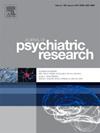机械约束的决定因素和言语降级技术在精神分裂症患者非自愿医院转院期间的作用
IF 3.7
2区 医学
Q1 PSYCHIATRY
引用次数: 0
摘要
机械约束(MR)是一个重要的伦理和临床问题,在精神科护理,应尽可能避免。通常推荐的避免MR的策略是口头降级(VD),但尚未有强有力的证据。这项自然主义观察性研究包括精神分裂症患者,他们在2008年至2020年期间由专业精神科家庭护理团队非自愿地从家中转移到急诊室。2013年,整个团队按照BETA项目的指导方针开始了VD技术的年度培训。该研究比较了引入VD训练前后的MR使用情况。它还旨在确定在这些转移期间使用MR的相关因素。临床和社会人口学特征比较需要MR和不需要MR的患者。在纳入研究的420例转移中,128例(30.5%)使用MR,而292例(69.5%)未使用MR。训练后,MR的使用减少了40%。多变量logistic回归分析确定了与MR使用相关的三个重要因素:VD的使用、panss -兴奋成分(PANSS-EC)评分(转移前评估)和年龄。PANSS-EC评分≥20与MR密切相关(OR = 4.36, 95% CI: 2.74-6.95)。这些发现表明,工作人员在VD方面的培训可能与精神分裂症患者非自愿转移期间减少MR使用有关。本文章由计算机程序翻译,如有差异,请以英文原文为准。
Determinants of mechanical restraint and the role of verbal de-escalation techniques in patients with schizophrenia during involuntary hospital transfer
Mechanical restraint (MR) is a significant ethical and clinical concern in psychiatric care and should be avoided whenever possible. A commonly recommended strategy to avoid MR, which is not yet strongly evidence-based, is verbal de-escalation (VD).
This naturalistic observational study included individuals with schizophrenia who were involuntarily transferred from their homes to the emergency room by a specialized psychiatric home care team between 2008 and 2020. In 2013, the entire team began annual training in VD techniques, following Project BETA guidelines. The study compares MR use before and after the introduction of VD training. It also aims to identify the factors associated with the use of MR during these transfers.
Clinical and sociodemographic characteristics were compared between those who required MR and those who did not. Among 420 transfers included in the study, MR was used in 128 cases (30.5 %), while 292 (69.5 %) were managed without it. After the training, there was a 40 % reduction in MR use.
A multivariate logistic regression analysis identified three significant factors that were associated with MR use: the use of VD, PANSS-Excited Component (PANSS-EC) score (assessed prior to transfer), and age. A PANSS-EC score ≥20 was strongly associated with MR (OR = 4.36, 95 % CI: 2.74–6.95).
These findings suggest that staff training in VD may be associated with reduced MR use during involuntary transfer of patients with schizophrenia.
求助全文
通过发布文献求助,成功后即可免费获取论文全文。
去求助
来源期刊

Journal of psychiatric research
医学-精神病学
CiteScore
7.30
自引率
2.10%
发文量
622
审稿时长
130 days
期刊介绍:
Founded in 1961 to report on the latest work in psychiatry and cognate disciplines, the Journal of Psychiatric Research is dedicated to innovative and timely studies of four important areas of research:
(1) clinical studies of all disciplines relating to psychiatric illness, as well as normal human behaviour, including biochemical, physiological, genetic, environmental, social, psychological and epidemiological factors;
(2) basic studies pertaining to psychiatry in such fields as neuropsychopharmacology, neuroendocrinology, electrophysiology, genetics, experimental psychology and epidemiology;
(3) the growing application of clinical laboratory techniques in psychiatry, including imagery and spectroscopy of the brain, molecular biology and computer sciences;
 求助内容:
求助内容: 应助结果提醒方式:
应助结果提醒方式:


